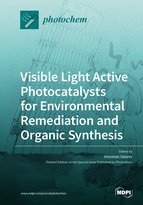Visible Light Active Photocatalysts for Environmental Remediation and Organic Synthesis
A special issue of Photochem (ISSN 2673-7256).
Deadline for manuscript submissions: closed (23 December 2021) | Viewed by 33826
Special Issue Editor
Interests: photocatalysis for sustainable chemistry; photocatalytic and photo-fenton processes for pollutants removal in wastewater; catalytic combustion of sewage sludge; decomposition and oxidative decomposition of H2S; hydrolysis of COS in the liquid phase
Special Issues, Collections and Topics in MDPI journals
Special Issue Information
Dear Colleagues,
In recent years the formulation of innovative photocatalysts activated by visible or solar light has been attracting increasing attention because of their interesting potential for environmental remediation and in organic synthesis reactions. Generally, the strategies for the development of visible light active photocatalysts are mainly focused on enhancing the degradation efficiency (in the case of environmental remediation) or increasing the selectivity towards the desired product (in the case of organic synthesis). These goals can be achieved by doping the semiconductor lattice with metal and/or non-metal elements in order to reduce the band gap energy, making the semiconductor able to absorb light at a wavelength higher than the UV range. Other interesting options are the formulation of different types of heterojunctions (to increase visible absorption properties and the concentration of photoactive surface sites), or to develop alternative catalytic materials, such as metal-organic frameworks (MOFs). This Special Issue is focused on “Visible Light Active Photocatalysts for environmental remediation and organic synthesis”, featuring the state-of-the-art in this field. Research and review papers related to the preparation and characterization of novel catalytic materials and their use in the visible (or solar light) driven photocatalytic removal of pollutants from liquid and gaseous phases are welcome in this Special Issue. Moreover, innovative photocatalyst formulations studied in chemical reactions devoted to the selective synthesis of organic compounds (e.g., phenol from benzene, aniline from nitrobenzene, methanol from methane, etc.) will be considered.
Dr. Vincenzo Vaiano
Guest Editor
Manuscript Submission Information
Manuscripts should be submitted online at www.mdpi.com by registering and logging in to this website. Once you are registered, click here to go to the submission form. Manuscripts can be submitted until the deadline. All submissions that pass pre-check are peer-reviewed. Accepted papers will be published continuously in the journal (as soon as accepted) and will be listed together on the special issue website. Research articles, review articles as well as short communications are invited. For planned papers, a title and short abstract (about 100 words) can be sent to the Editorial Office for announcement on this website.
Submitted manuscripts should not have been published previously, nor be under consideration for publication elsewhere (except conference proceedings papers). All manuscripts are thoroughly refereed through a single-blind peer-review process. A guide for authors and other relevant information for submission of manuscripts is available on the Instructions for Authors page. Photochem is an international peer-reviewed open access quarterly journal published by MDPI.
Please visit the Instructions for Authors page before submitting a manuscript. The Article Processing Charge (APC) for publication in this open access journal is 1000 CHF (Swiss Francs). Submitted papers should be well formatted and use good English. Authors may use MDPI's English editing service prior to publication or during author revisions.
Keywords
- photocatalysis
- visible or solar light
- doped and co-doped semiconductors
- heterojunctions
- Metal-Organic Framework (MOFs)
- water and wastewater treatment
- gaseous pollutant removal
- organic synthesis





